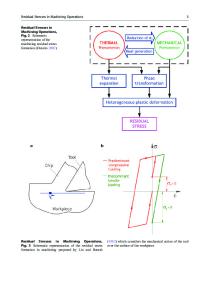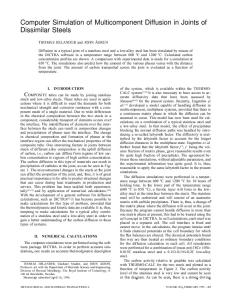Fundamentals of Residual Stresses in Joints Between Dissimilar Materials
- PDF / 634,548 Bytes
- 3 Pages / 576 x 777.6 pts Page_size
- 111 Downloads / 350 Views
MRS BULLETIN/JANUARY 1995
terize residual stress/strain states within joints. Because the availability of experimental data is often limited, mathematical models play a key role in joint design and analysis. When developing a mathematical model, one often chooses between a macromechanical, analytical approach based on various simplifying assumptions and a finite-element, numerical model which can be as complicated as desired, including geometric complexities, nonlinear material behavior, and even micromechanical effects. In choosing the type of model to use, tradeoffs frequently exist between efficiency and accuracy. For initial design studies where high accuracy is not necessary and the primary intent is to generate qualitative or comparative information, the use of simple analytical relations can be adequate. Alternatively, final designs may require as much accuracy as possible, justifying the added time and ex-
ceramic metal
pense of finite-element modeling. Using either approach, it is important that efforts be made to verify modeling results by comparison with experimental data. Figure 2 shows finite-element computed stress fields for a cylindrical Ni-Al2O3 bilayer disk-shaped specimen which has been cooled from 1100 K. Radial (in-plane) stresses are largest at the axis of symmetry and are tensile in the metal, but, due to the significant bending that occurs for this specimen geometry, the radial stresses vary almost linearly across the ceramic from compressive near the interface to tensile at the bottom surface. Large axial and shear stresses exist near the outer radius, decreasing rapidly away from the radial free surface. Since essentially all of the metal layer undergoes plastic deformation, stresses are limited to values on the order of the yield strength; large plastic strains (>5%) are concentrated locally at the material interface near the free surface. Analytical experience has demonstrated the importance of including plasticity effects, and using very fine meshing near the material interface and free-surface intersection. The limited availability of temperature-dependent material property data often hinders modeling efforts. Stresses and strains in dissimilar material joints can be measured experimentally using a variety of techniques. In the case of diffraction methods (x-ray or neutron), strains are measured directly as a shift in lattice spacing, and stresses can be calculated from strains assuming isotropic elasticity and using known or measured elastic constants. X-rays have penetration depths typically limited to several microns, so that strain/stress field information is limited to the near-surface region of the specimen. Alternatively, neutrons can penetrate sev-
-O-
metal
-D-
-CD-
ceramic
initial state (stress-free)
cooling by AT: unconstrained: unconstrained displacement continuity at interface °m = -°c = EAaAT
surface forces applied for stress-free surface requirements
Figure 1. Schematic showing the origin of stresses caused by a temperature change for a bonded ceramic-metal s
Data Loading...










